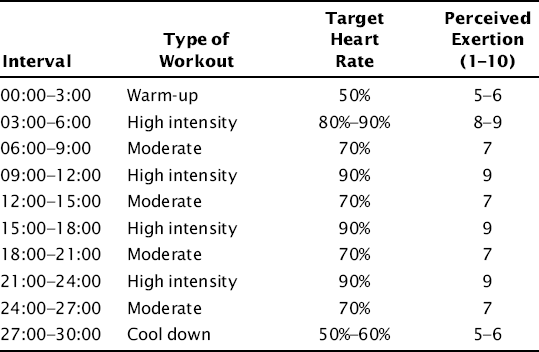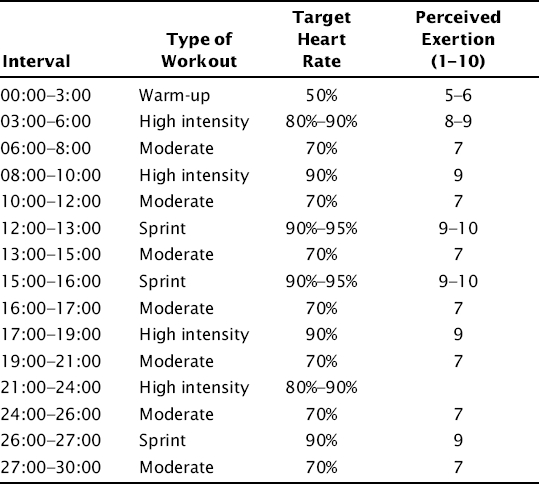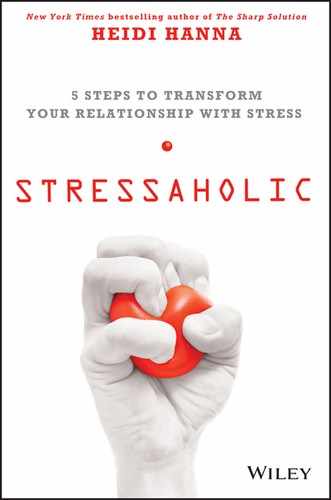6
Step 3: Rebuild
To fully recharge your energy, it's crucial to train your brain and body to work even better than they have in the past. You're not just restoring balance here; you're creating the best possible operating system by building up energy reserves and strengthening resilience. To do this, you create strategic training stress that requires you to push a little outside of your comfort zone, using both physical and cognitive exercises designed to optimize your performance. Keep in mind that as you start to build up your energy reserves, it becomes even more critical to continue to invest strategically in relax and repair techniques during the day. If you stretch out of your comfort zone to train without having the necessary energy resources, you may find yourself starting to break down again. You might even become dependent on stress hormones and overstimulation to keep you going, as you have in the past.
To optimize your training and get the most return on your investment, you need to continue to build in reliable recharge breaks throughout the day, regardless of whether you feel like you need them. I can promise that you do.
Strengthen the Mind: Cognitive Training
When we think of the word fitness, we usually think of physical fitness, or our body's ability to do work. The elements of physical fitness include three primary areas: strength, flexibility, and endurance. To be fit, you need to develop and maintain all three through strategic training. The brain is another part of our body that we need to keep in shape if we want it to function at its best. The fitter the brain is, the more energy efficient it becomes, and the easier it is to do important mental tasks, such as focusing attention, remembering information, and being creative.
The elements required for our brain to be fit are the same as those required for our bodies. To be mentally sharp and able to focus on what's most important to us—and to be able to sustain that focus over time—we need to train our cognitive strength to be fully present in the moment, our flexibility to be adaptable and creative, and our endurance to sustain performance and resilience as we age. Paying attention to these dimensions of our mental energy not only helps us be as sharp as we can in our current career and our relationships but also gives us the edge to be healthy and happy as we age.
I discuss the three elements of cognitive fitness in more depth in my previous book, The SHARP Solution: A Brain-Based Approach for Optimal Performance. If you're interested in more details about how to holistically train your brain to be healthy and fit, I encourage you to check out that resource or visit the training programs available for free at www.synergyprograms.com/braingym.
In previous chapters, we discussed a few cognitive fitness strategies that help us rest and repair our mental energy—deep breathing, relaxation exercises, and gratitude practices. To continue our work, let's focus on a few more techniques that help us to gently rebuild our cognitive reserves for added resilience.
Creating Coherence
Newer research has pointed to a significant measure of the interactions between autonomic nervous system dynamics that control our stress and those that control our relaxation responses, called heart rate variability (HRV). In addition to measuring our heart rate, HRV accounts for the activity of both the sympathetic (stress) and the parasympathetic (recovery) system, as well as the synchronization between the two. Put simply, this is like being able to test our ability to apply both our internal gas pedal for fuel and our brake pedal when we need to slow down or come to a complete stop.
HRV devices use a pulse sensor, usually placed on the fingertip or ear, to provide instant feedback on the current rhythmic patterns occurring at a cardiovascular level. Research by the Institute of HeartMath has identified a distinct mode of functioning frequently associated with the experience of sustained positive emotion that the organization calls physiological coherence. For this purpose, coherence is used to describe a mode that encompasses a range of internal shifts that emerge when the body is able to bring operations into a more harmonious state. According to HeartMath, physiological coherence helps synchronize the two branches of the autonomic nervous system (the “gas pedal” and the “brake pedal”), increases communication between the heart and the brain, and creates a harmonious relationship among the various internal rhythms of our oscillatory systems (such as heart rate, breath rate, brain waves, and blood pressure).1
Research shows that increasing heart rhythm coherence is linked to many factors that contribute to wellness. Coherence is more than simple relaxation; it is a focused state of dynamic balance between the sympathetic and the parasympathetic branches of the autonomic nervous system. You can learn to function in this state while at rest, work, or play. Because HRV training is easy and self-directive, it can be a powerful tool to help generate an increased state of coherence at will, thereby reducing stress and improving health, well-being, and performance. There are several HRV training devices available for use. My favorites include the EmWave and Inner Balance programs, both by HeartMath (www.heartmath.com); the free iPhone app GPS for the Soul; and My Calm Beat by My Brain Solutions (www.mybrainsolutions.com/mycalmbeat). An added feature of My Calm Beat is a simple series of tests you can use to identify your unique ideal breath rate, which allows you to set the device to train within the parameters best suited for your preferences.
Strengthen the Body: Interval Training
Although there are many ways to strengthen our physical system, one technique that has been shown time and again to boost both physical and mental performance is cardiovascular or aerobic training. According to the Human Performance Institute, cardiovascular training is the most efficient and effective method for increasing our aerobic fitness and energy-generating capacity.2 Any activity that involves continuous movement can be considered aerobic—including running, cycling, swimming, and walking, in addition to dancing, playing sports, and circuit training with weights or body weight. Ideally, we want to perform cardiovascular training a minimum of three times a week, with no more than two days of rest between workouts. The intensity of the exercise is the key factor in determining the return on investment.
You can typically measure intensity by your perceived exertion or your heart rate. Purchasing and regularly using a heart rate monitor is one of the best investments you can make to support your fitness program, because it gives you an objective measure of your target training zone. Your estimated maximum heart rate can be calculated by taking 220 minus your age. According to the American College of Sports Medicine, the target heart rate zone for maximizing cardiovascular improvements is 70 to 90 percent.3 If you are unable to measure your heart rate, you can use your perceived exertion, which is a score you assign to how you're feeling in the moment by rating your effort level on a scale of 1 to 10. Consider a moderate walk a 4 or 5 and a full-out sprint that you could sustain only for a few seconds to be your maximum effort.

Continuing the theme that we've been focused on throughout this book, interval training incorporates the notion of oscillation by using periods of higher intensity and lower intensity to create a cyclic format. Many studies have cited the benefits of interval training over other types of workouts. This approach gives exercisers the chance to push higher out of their comfort zone, which triggers an even greater initial stress response and then gives the opportunity to decrease intensity for periods of active rest so that the body learns to get into recovery mode more quickly over time. These spikes of intensity increase metabolism and may burn more calories and fat than more static types of exercise routines.4
There are numerous advantages to using interval training during your cardio workout:
- Your heart and lungs become bigger, stronger, and better able to take on intense challenges more efficiently and to recover more quickly.
- You boost your metabolism, causing you to burn extra calories for up to 48 hours after your training session (as explained further in the next section).
- A constantly changing workout is more interesting.
- It's easier to get started with an interval training workout by focusing on the short amount of time for each sprint (1 to 3 minutes).
- You can get maximum return on your investment by going for quality over quantity.
Sample Interval Training Workout
You can always adjust your training segments to keep things changing and keep the body challenged; they do not have to be the same length. You can also combine cardiovascular and strength training by stepping off the machine during the recovery phase and doing light dumbbell or resistance band exercises. Consider the following sample interval training workout.

Once you get used to the concept of interval training, you can easily mix up your workout to keep the body challenged, such as in the next sample workout. Depending on what you like to do, you can vary several factors of your exercise:
- Type: treadmill, elliptical machine, rowing machine, body weight circuit, and so on
- Frequency: three times versus five or six times a week
- Duration: 20 minutes at higher intensity (sprint versus jog) with perceived exertion of 8 to 10 or a longer workout at a lesser intensity, like 45 minutes with perceived exertion 7 to 9; you can also modify the length of the actual sprint and recovery segments.

It has been well established that your body expends a greater amount of energy bringing itself back to a pre-exercise state after intense exercise, a concept summarized by excess postexercise oxygen consumption (EPOC). The specific functions that use more oxygen, and therefore burn more calories, include replenishing oxygen stores, resynthesizing phosphagen (adenosine triphosphate phosphocreatine), removing lactate, and increasing ventilation, blood circulation and body temperature above pre-exercise levels. EPOC's magnitude depends on the intensity and duration of exercise. It generally takes between 15 minutes and 48 hours for the body to return to its pre-exercise state. Intensity is the biggest factor in the amount of calories consumed during exercise and afterward through EPOC.
A lot of people don't have enough time to work out all at once as much as they'd like. The good news is that several studies have demonstrated that EPOC is greater after splitting a workout into two shorter bursts of exercise than after one longer workout.5 Like much of what we've discussed in this book, it's crucial to stay focused on the quality of energy we bring to the time we're training. It's not enough to merely go through the motions to check off another box on our to-do list. Too many people spend too much time in the gym without getting the results they desire because their focus is distracted. When you're investing in rebuilding your system, both mentally and physically, you have to be completely engaged in the activity at hand. Then, you can quickly move on to more restful and relaxing recovery strategies to help you get the most benefit from your time and energy investment.
- Schedule recovery breaks, and make them a priority.
- Create coherence with HRV training.
- Increase energy through physical interval training.
Stepping Stone 3: Let in, Let Go, and Find Your Ideal Flow
Life is a series of beats. Everything that has life has a natural rhythm of ups and downs, giving and receiving, stress and recovery. We can find our optimal performance pulse by tuning in to our natural oscillation process, which is facilitated by our internal rhythms—our inhales and exhales, heartbeats, blood sugar fluctuations, brain waves, and so on. Even our energy levels naturally rise and fall during the day.
Look at your personal routine. When do you notice yourself feeling most energized? When during the day do you experience energy dips or crashes? Although feeling burned out or exhausted is not natural, we have to expect our energy levels to naturally rise and fall in alignment with our resources. Often, our energy is greatest in the morning when we first arise and cortisol levels are highest. There's usually a dip in the afternoon during a circadian rhythm drop (otherwise known as the nap zone, typically felt around 3:00 or 4:00 PM). Then there's a steep decline in the evening as cortisol levels drop and sleep-inducing melatonin begins to increase.
When we fight our natural rhythms—or worse, try to override them with stimulants such as caffeine or stress hormones—we essentially force our system to slowly adapt to being on all of the time. Although we may consider this a good thing for productivity, we must recognize that the results of nonstop stimulation are toxic to both the brain and the body. They rob us of the time and energy we're trying to conserve.
Like training a new muscle or skill, time and repetition allow us to strengthen our ability to recalibrate our natural rhythm. We're able to create a more optimal pulse or flow that provides us with greater amounts of energy for short periods. In addition, we use a consistent recharge process to invest energy back into our system for resilience and sustainability.
Try it now. Read the following instructions, and then walk through the steps on your own. You can also download a guided meditation track directing this practice at www.synergyprograms.com/stressaholic.
